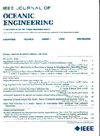浅水能量电缆分布式声传感
IF 5.3
2区 工程技术
Q1 ENGINEERING, CIVIL
引用次数: 0
摘要
分布式声传感(DAS)提供了一种测量光纤电缆应变动态变化的方法,在基础设施监测、地震预警和灾害评估方面具有许多潜在的应用。以前的工作主要集中在海底通信电缆上,它只包含光纤电缆。在这里,我们关注的是能源电缆的使用,它传输来自海上由潮汐或风力驱动的发电机的电力,并包含用于与发电机通信的光纤电缆。具体来说,我们关注的是位于英国伊迪奥克尼的欧洲海洋能源中心,这是一个潮汐发电站。能源电缆由于传输能量而产生温度波动,并且存在强烈的波浪作用和潮汐流,这些都会对DAS产生噪声。我们表明,在没有能量传输的一段时间内,沿电缆的噪音水平会发生变化,但在电信电缆上报道的许多现象仍然可以观察到,包括海浪和附近的小型船只。小船信号在频带能量图上的特征沿电缆长度变化,在某些区域出现多个频带能量峰。这种变化是对电缆埋藏状态的诊断。了解能源电缆的埋藏状态对于了解系统的机械保护非常重要,可以最大限度地减少与周围环境和生态系统的热相互作用。本文章由计算机程序翻译,如有差异,请以英文原文为准。
Distributed Acoustic Sensing Along a Shallow Water Energy Cable
Distributed acoustic sensing (DAS) provides a means of measuring dynamic changes in strain along a fiber-optic cable and has many potential applications for monitoring infrastructure, earthquake early warning, and hazard assessment. Previous work has focused on submarine telecommunications cables, which contain only fiber-optic cables. Here, we focus on the use of energy cables, which transmit electricity from offshore generators powered by tides or wind and contain fiber-optic cables for communications with the generators. Specifically, we focus on the European Marine Energy Center in Orkney, Eday, U.K., a tidal power station. Energy cables fluctuate in temperature due to energy transmission, and there is strong wave action and tidal flows, which all generate noise for DAS. We show that noise levels vary along the cable during a time with no energy transmission, but many phenomena reported on telecommunication cables are still observable, including ocean waves and nearby small vessels. The character of the small vessel signals in frequency band energy plots varies along the cable length, in some areas exhibiting multiple frequency band energy peaks. This variation is diagnostic of the burial state of the cable. Knowing the burial state of energy cables is important for understanding the mechanical protection of the system for minimizing thermal interactions with the surrounding environments and ecosystems.
求助全文
通过发布文献求助,成功后即可免费获取论文全文。
去求助
来源期刊

IEEE Journal of Oceanic Engineering
工程技术-工程:大洋
CiteScore
9.60
自引率
12.20%
发文量
86
审稿时长
12 months
期刊介绍:
The IEEE Journal of Oceanic Engineering (ISSN 0364-9059) is the online-only quarterly publication of the IEEE Oceanic Engineering Society (IEEE OES). The scope of the Journal is the field of interest of the IEEE OES, which encompasses all aspects of science, engineering, and technology that address research, development, and operations pertaining to all bodies of water. This includes the creation of new capabilities and technologies from concept design through prototypes, testing, and operational systems to sense, explore, understand, develop, use, and responsibly manage natural resources.
 求助内容:
求助内容: 应助结果提醒方式:
应助结果提醒方式:


